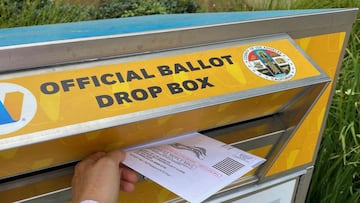Can you have a recall election for a president? How many elected officials have been recalled?
Is it possible to recall a president? Our team took a look at what political officials can be recalled and how many leaders in the past have been.


Recall elections are gaining interest in the mainstream as the Governor of California, Gavin Newsom, faces an election of this nature on 14 September.
One question circulating is if it is possible to remove a president through a recall election.
When the drafters of the constitution were evaluating the punishments Senators and Presidents could be subjected to, recalls were ruled out.
The President of the United States cannot be recalled. Rather they can be impeached and removed from office by Congress. An act of this nature was attempted twice under Presidnet Donald Trump. However, each time, he was acquitted in the Senate after being impeached in the house.
In most states that allow a recall election to take place, voters in the state decided the fate of the governor or other official. When it comes to impeachment, only those in the House of Representatives and Senate vote on the matter.
Which political offices can be recalled?
The only high-level politicians in the US who can be recalled are governors. In twenty states, governors can be recalled through various means. The remaining states do not have laws on the books that allow for the removal of a governor through recall elections.
Additionally, most small political jurisdictions in the US, such as countries, cities, and towns, allow for the recall of public officials. Most recently, in 2020, city council members in Santa Cruz, California, and Sebastian, Florida, were recalled because of misconduct and allegations of malfeasance, respectively.
“They’re a statement in favour of democracy.” Political analyst Joshua Spivak tells “Checks and Balance” that recall elections can destabilise, but they are a part of America’s more democratic system https://t.co/S5VWbTkMI2 pic.twitter.com/NdtcLRzu89
— Podcasts from The Economist (@EconomistPods) September 2, 2021
Gubernatorial Recalls
Although only two governors have ever been successfully recalled in US history, a fifth of states have laws on the books allowing the practice. However, various types of recalls exist in the US, and they can be broken down into four major categories:
- Simultaneous recall election;
- Separate special election;
- Retention recall election; and
- Recall trial.
Simultaneous recall election
Six states -- Arizona, California, Colorado, Nevada, North Dakota, and Wisconsin -- allow for a simultaneous recall election which can take two forms.
The first is what Ballotopedia calls a “standard subnational election, in which any number of challenges in which any number of challengers may appear on the ballot alongside the sitting governor.”
If one of the challengers garner more votes than the sitting governor in the election, they assume power. If the governor receives more votes, then they maintain their position.
The second type of election is called a two-part election in which registered voters are asked two questions:
- Should the current governor be recalled?
- And if so, who should replace them?
Should the majority of voters vote not to recall the governor, the second question is considered “void.”
A two-part election is what is occurring in California.
Voters are asked whether they would like to recall Gavin Newsom, and if they vote YES, they are asked who they believe should replace him. While Gavin Newsom currently holds the lead in the polls, Democrats are wary after Gov. Gray Davis was recalled in 2003, leading to the governorship of actor Arnold Schwarzenegger.
Separate special election
The next type of recall is called a separate special election and is similar to the two-part election described above.
Rather than the ballot posing two questions, the election process is broken into two phases. During the first phase, voters are asked one question: if they would like to recall the governor. If a majority votes to remove the leader, another election is taken place to elect the successor.
In most cases, the lieutenant governor takes over until the special election can take place.
This recall is the most common and forms part of state law in Georgia, Illinois, Louisiana, Minnesota, Montana, New Jersey, Oregon, and Rhode Island.
Retention recall election
The third type of recall is known as a retention recall election and can be seen in Alaska, Idaho, Kansas, Michigan, and Washington.
This type of recall shares some similarities with the separate special election.
Elections are held to ask voters if they would like to recall the governor. If a majority votes to keep them in office, they remain. However, if a majority chooses to recall, the governor must step down and normally replace the lieutenant governor until elections are held; no special election is held.
Recall trial
Recall trials are the least common form of removing a governor. Only Virginia uses this method.
In Virginia, the governor is tried before a circuit court. In the case the governor would rather be heard by a jury, a request can be made. Should the decision not go in the governor’s favor, an appeal can be made to the Supreme Court of Virginia.
Should the court find that the recall is valid, the governor will be removed from office and replaced.
What governors have been removed from office?
The first governor to be removed from office through a recall was Lynn Frazier of North Dakota in 1921. After being re-elected for a second term, an economic depression rocked the state, leading to a grassroots movement calling for the recall of Gov. Frazier.
Until 2003, Frazier was the only governor to have been recalled.
However, California governor Gray Davis lost his recall election and was succeeded by Arnold Schwarzenegger.
Davis had been elected for a second term. Still, shortly after, a Republican-led by Representative Darrell Issa, who had hoped to replace Davis, gathered enough signatures to prompt a recall.
Related stories
The petition circulated read “[Governor Davis's actions were a] gross mismanagement of California Finances by overspending taxpayers' money, threatening public safety by cutting funds to local governments, failing to account for the exorbitant cost of the energy, and failing in general to deal with the state's major problems until they get to the crisis stage.”
Although leading up to the election many polls showed him the lead, Davis lost the recall with the YES votes representing around 55 percent.

